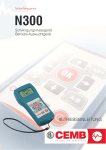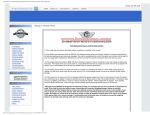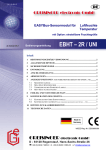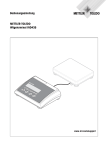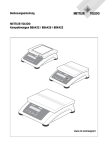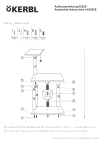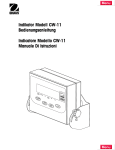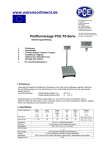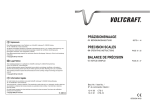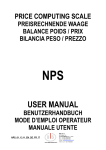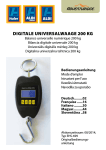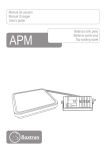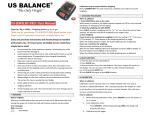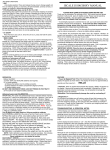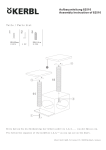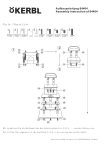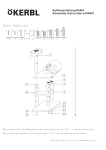Download Tischwaage 150 kg
Transcript
Tischwaage 150 kg Balance de table 150 kg Bench scale 150 kg Bilancia da cucina 150 kg DE FR EN IT Bedienungsanleitung Mode d’emploi Instructions for use Istruzioni per l’uso Albert Kerbl GmbH 84428 Buchbach • Felizenzell 9, Germany Tel.: +49 8086 933-100 • Fax: +49 8086 933-500 [email protected] • www.kerbl.com 1 DE Sicherheitshinweise ! WARNUNG Bei Missachtung dieses Hinweises können Ihnen starke Schäden am Produkt oder Verletzungen Ihrerseits entstehen. Daher bitte unbedingt diesen Hinweis beachten. ! ACHTUNG Dieser Hinweis gibt Ihnen eine Information zur Vermeidung von Schäden. Wenn Sie die Waage verwenden, bitten wir Sie unbedingt die folgenden Punkte zu beachten: ! WARNUNG Verwenden Sie nur den im Lieferumfang befindlichen AC-Adapter. Andere Adapter können das interne Netzteil beschädigen. ! ACHTUNG • Setzen Sie die Waage nie direkter Sonnenstrahlung aus, dieses könnte sonst zu Fehlfunktionen führen. • Verwenden Sie immer nur Batterien eines gleichen Typs. Tauschen Sie immer alle Batterien gleichzeitig aus. • Wenn Sie die Waage längere Zeit nicht benutzen, entfernen Sie bitte alle Batterien aus dem Batteriefach, um eine Waagen – Beschädigung durch auslaufende Batterien zu vermeiden. • Vermeiden Sie die Waage zu überladen => das kann zu Schäden an der Waage führen! • Vermeiden Sie, dass Wassertropfen in das Innere der Waage gelangen. Eine innere Korrosion führt zu Schäden. • Eine statische Aufladung beeinflusst die digitale Messtechnik. Entladen Sie also Bauteile, die Sie verwiegen möchten vorher oder verwenden Sie antistatisches Spray (z.B. auch auf der Wägeplattform). Stellen Sie die Waage nie in der Nähe starker elektrischer Felder auf. 2 Beschreibung der Oberfläche • seitlich AC Adaptor Buchse ON/OFF Taste Ein- und Ausschalten der Waage HOLD Taste Wert bleibt für 120 Sek. am Display UNIT Taste Auswahl der Einheit (kg oder Ib) ZERO Taste (TARA) Setzt die Anzeige auf „Null“ Zieht die Masse eines Behälters ab • Display Anzeige des negativ Wertes Wägeeinheit Stabilitätsindikator Hold Indikator Anzeige Batteriekapazität ZERO Indikator 3 Hold - Funktion Wenn Sie die HOLD-Taste drücken: 1) Die CPU sendet den aktuellen Wägewert zur RS232-Schnittstelle. 2) Der Wägewert wird für ca. 120 Sek. im Display gehalten 1) Legen Sie das Wägegut auf die Plattform. 2) Warten Sie, bis die Anzeige sich stabilisiert hat. 3) Drücken Sie die HOLD-Taste. Der “.” Hold-Indikator leuchtet auf. 4) Nehmen Sie das Wägegut von der Plattform. Der Wägewert bleibt nun für 120 Sek. im Display erhalten. 5) Hold-Funktion wieder löschen: Drücken Sie die HOLD-Taste erneut. Der “.” Hold-Indikator erlischt und der aktuelle Wägewert erscheint. Weitere Funktionen 1. Wechseln Sie in den Funktionsmodus: Drücken Sie die [ON/OFF] Taste, um die Waage auszuschalten. Drücken und halten Sie die [HOLD] Taste gedrückt, dann drücken Sie die [ON/OFF] Taste/das Display zeigt A_ON oder A_OFF. 2. An- oder Abwahl der automatischen Abschaltfunktion: Wenn Sie im Funktionsmodus sind, zeigt das Display A_ON oder A_OFF. Drücken Sie die [ZERO] Taste, die Auswahl A_ON bedeutet, die automatische Abschaltung (nach 2 min.) ist aktiv. Drücken Sie die [ZERO] Taste erneut. Das Display zeigt A_OFF, das bedeutet, die automatische Abschaltung ist deaktiviert. 3. An- oder Abwahl der Hintergrundbeleuchtung: Wenn Sie im Funktionsmodus sind, drücken Sie die [HOLD] Taste, das Display zeigt L_ON oder L_OFF. Drücken Sie die [ZERO] Taste, die Auswahl L_ON bedeutet, die automatische Hintergrundbeleuchtung ist aktiv. Drücken Sie die [ZERO] Taste erneut. Das Display zeigt L_OFF, das bedeutet, die automatische Hintergrundbeleuchtung ist deaktiviert. Wägevorgang Vorbereitung Geben Sie der Waage nach Einschalten zunächst eine Aufwärmzeit bevor Sie mit dem Wiegen beginnen. Meldungen EEEE: Überlastung der Wägezelle (Overload) : niedriger Batteriestatus Wägevorgang 1. Drücken Sie die [ON/OFF] Taste, um die Waage einzuschalten. Bei Einschaltung leuchten zunächst alle Display Segmente für einige Sekunden auf; danach erscheint die Anzeige “0”. 2. Auswahl der Wägeeinheit [UNIT]. Drücken Sie die [UNIT] Taste, um “kg” oder “Ib” auszuwählen. Wenn die Einheit ausgewählt ist, wird sie neben dem Wägewert angezeigt. 3. Wägearten Wägung ohne Behälter Achten Sie darauf, dass das Display vor Belastung der Plattform eine “0” anzeigt. Wenn nicht, drücken Sie die [ZERO/TARE] Taste. Legen Sie das Wägegut auf die Plattform. Wenn der angezeigte Wert stabil ist, lesen Sie ihn ab. 4 Wägung mit Behälter Setzen Sie den leeren Behälter auf die Plattform. Warten Sie, bis die Anzeige stabil ist. Drücken Sie dann die [ZERO/TARE] Taste. Füllen Sie das Wägegut in den Behälter und setzen Sie ihn auf die Plattform. Wenn die Anzeige stabil ist, lesen Sie den Wägewert ab. Kalibrierung Bei der Erstaufstellung ist die Waage natürlich noch werkskalibriert. Daher ist eine erneute Kalibrierung bei Erhalt der Waage nicht notwendig. Wenn die Waage am Aufstellungsort starken Umwelteinflüssen (Staub, Schmutz, hohe Luftfeuchte) unterliegt, kann die Waage aber rekalibriert werden. Wie wird kalibriert? (Achtung: Information nur für Kalibrierdienste) **Eine Kalibrierung darf ausschliesslich nur durch akkreditierte Kalibrierlabors durchgeführt werden!!** 1. Die Waage muss ausgeschaltet sein [OFF]. Drücken und halten Sie die [ZERO] Taste, dann drücken Sie auf [ON/OFF], dabei halten Sie die [ZERO] Taste gedrückt, dann lassen Sie beide Tasten los. Im Display erscheint A/D (eine zufällige Ziffernfolge). 2. Warten Sie, bis sich die Anzeige stabilisiert Drücken Sie die [UNIT] Taste. Das Display zeigt „0SAVE“, danach A/D Zahlen (zufällige Ziffernfolge). Setzen Sie die Kalibriergewichte (entsprechend des maximalen Wägebereiches (z.B.: 60 oder 150 kg)) auf die Plattform auf. Warten Sie, bis sich die Anzeige stabilisiert, dann drücken Sie die [UNIT] Taste / das Display zeigt „0SAVE“. Die Kalibrierung ist abgeschlossen / nehmen Sie die Kalibriergewichte von der Plattform. Schalten Sie die Waage aus [ON/OFF], dann wieder ein [ON/OFF] und führen Sie einige Probewägungen mit einer Kalbriermasse aus.Wenn Sie Abweichungen feststellen sollten, dann führen Sie die Kalibrierprozedur erneut durch. Achtung: Während der Kalibrierung sollte die Waage stabil und vibrationsfrei stehen. Merkmale • Automatische Selbstabschaltung • Display inkl. Wandhalterung • Hold-Funktion • Wägeeinheit: kg / Ib 5 Spezifikationen Modell Kapazität Ablesbarkeit (d) 29924 150 kg 50 g Genauigkeitsklasse III Eichwert e = d = 50 g Plattform 330 x 320 mm Netto-/Bruttogewicht 4,1 kg/4,5 kg Display 6-stellig/15 mm LCD-Ziffernhöhe Einsatztemperatur 15° C – 30° C Stromversorgung 6x AA Batterien oder AC/DC-Adapter Ladegerät 9 V/100 mA **Warnung** Die Verwendung von Mobiltelefonen oder anderen elektronischen Artikeln mit hoher Sendeleistung kann zu einer Interferenz führen und die Waage zeitweise beeinflussen. Dies gilt ebenfalls für die Durchführung einer Kalibrierung. Schnittstellenbeschreibung (Software + Datenkabel optional) ASC II Code Parameter Bits pro Sekunde (Baudrate) Parität (Parity bit) Datenbits (Data bit) Stoppbits (Stop bit) 9600 keine (none) 8 1 Albert Kerbl GmbH Felizenzell 9 84428 Buchbach, Germany www.kerbl.de E-Mail: [email protected] 6 FR Consignes de sécurité ! AVERTISSEMENT Le non-respect de cette consigne peut entraîner un grave endommagement du produit ou des blessures. Pour cette raison, veuillez respecter absolument cette consigne. ! CAUTION Cette consigne vous donne une information sur la manière d’éviter les dommages. Veuillez absolument respecter les points suivants lorsque vous utilisez la balance : ! AVERTISSEMENT Utilisez exclusivement l’adaptateur AC fourni. D’autres adaptateurs pourraient endommager le bloc d’alimentation interne. ! CAUTION • N’exposez jamais la balance directement aux rayons du soleil car cela peut provoquer des défaillances. • N’utilisez que des piles identiques. Remplacez toujours toutes les piles en même temps. • Si vous n’utilisez pas la balance pendant une période prolongée, veuillez enlever toutes les piles du compartiment afin d’éviter d’endommager la balance en cas de fuite des piles. • Evitez de surcharger la balance => ceci peut endommager la balance ! • Eviter de laisser des gouttes d’eau pénétrer à l’intérieur de la balance. Une corrosion interne provoque des dommages. • Un chargement statique a une influence sur la technique numérique de mesure. Déchargez les composants que vous souhaitez peser au préalable ou utilisez un spray antistatique (par ex. sur la plate-forme de pesage également). N’installez jamais la balance à proximité d’un fort champ électrique. 7 Description de la surface • Latérale Adaptateur AC Douille Touche ON/OFF Démarrage et arrêt de la balance Touche HOLD La valeur reste affichée pendant 120 sec. sur l‘écran Touche UNIT Sélection de l’unité (kg ou Ib) Touche ZERO (TARA) Met l’affichage sur « zéro » Soustrait le poids d’un récipient • ECRAN Affichage de la valeur négative Unité de pesage : Indicateur de stabilité Affichage de la capacité de la batterie Indicateur Hold Indicateur ZERO 8 Fonction HOLD Lorsque vous appuyez sur la touche HOLD : 1) Le CPU envoie la valeur actuelle à l’interface RS232 2) La valeur de pesage est affichée pendant env. 120 sec. sur l’écran. 1) Posez le bien à peser sur la plate-forme. 2) Attendez que l’affichage se stabilise. 3) Appuyez sur la touche hold. L’indicateur Hold « . » s’allume. 4) Retirez le bien à peser de la plate-forme. La valeur reste maintenant affichée sur l’écran pendant 120 sec. 5) Supprimer encore une fois la fonction Hold : Appuyez encore une fois sur la touche HOLD. L’indicateur Hold « . » s’éteint et la valeur de pesage actuelle s’affiche. Autres fonctions 1. Passez en mode fonctionnel : Appuyez sur la touche [ON/OFF] pour éteindre la balance. Appuyez sur la touche [HOLD], maintenez-la enfoncée puis appuyez sur la touche [ON/OFF] / l’écran affiche A_ON ou A_OFF. 2. Sélection ou désélection de la fonction d’arrêt automatique : Si vous êtes dans le mode fonctionnel, l’écran affiche A_ON ou A_OFF. Appuyez sur la touche [ZERO], la sélection A_ON signifie que l’arrêt automatique (après 2 min.) est actif. Appuyez une nouvelle fois sur la touche [ZERO]. L’écran indique A_OFF. Cela signifie que l’arrêt automatique est désactivé. 3. Sélection ou désélection de la fonction de rétroéclairage automatique: Si vous êtes dans le mode fonctionnel, appuyez sur la touche [HOLD], l’écran affiche L_ON ou L_OFF. Appuyez sur la touche [ZERO], la selection L_ON signifie que le rétroéclairage automatique est actif. Appuyez une nouvelle fois sur la touche [ZERO]. L’écran indique L_OFF. Cla signifie que le rétroéclairage automatique est désactivé. Procédure de pesage Préparation Après avoir allumé la balance, saisissez un temps de chauffe avant de commencer le pesage. Alertes EEEE: Surcharge de la cellule de pesage (Overload) : Statut de batterie faible Procédure de pesage 1. Appuyez sur la touche [ON/OFF] pour allumer la balance. Lors du démarrage, tous les segments s’allument sur l’écran pendant quelques secondes puis l’affichage « 0 » apparaît. 2. Sélection de l’unité de pesage [UNIT]. Appuyez sur la touche [UNIT] pour sélectionner « kg » ou « Ib ». Une fois l’unité sélectionnée, elle s’affiche à côté de la valeur de pesage. 3. Types de pesage Pesage sans récipient Veillez à ce que l’écran affiche « 0 » avant de charger la plate-forme. Si tel n’est pas le cas, appuyez sur la touche [ZERO/TARE]. Posez le bien à peser sur la plate-forme. Une fois que la valeur affichée est stable, lisezla. Pesage avec récipient Installez le récipient vide sur la plate-forme. Attendez que l’affichage se stabilise. Appuyez ensuite sur la touche [ZERO/TARE]. Remplissez le récipient avec le bien à peser puis posezle sur la plateforme. Une fois la valeur stabilisée, lisez la valeur. 9 Calibrage Lors de la première installation, la balance est encore calibrée comme à l’usine. C’est pourquoi un nouveau calibrage est nécessaire à la réception de la balance. La balance peut être calibrée une nouvelle fois si elle est soumise à de fortes influences environnementales sur le lieu de montage (poussière, salissures, humidité élevée). Comment effectuer le calibrage ? (Attention : information valable uniquement pour le calibrage) ** Le calibrage ne doit être effectué que par un laboratoire de calibrage accrédité. ** 1. La balance doit être éteinte [OFF]. Appuyez sur la touche [ZERO], maintenez-la enfoncée, appuyez ensuite sur [ON/OFF] puis relâchez les deux touches. A/D (une suite aléatoire de chiffres) s’affiche sur l’écran. 2. Attendez que l’affichage se stabilise puis appuyez sur [UNIT]. L’écran affiche « 0SAVE » puis les chiffres A/D (ordre aléatoire). Posez le poids de calibrage (correspondant à la plage de pesage maximale (par ex. 60 ou 150 kg)) sur la plate-forme. Attendez que l’affichage se stabilise puis appuyez sur [UNIT] / l‘écran indique « 0SAVE ». Le calibrage est terminé / enlevez les poids de calibrage de la plate-forme. Eteignez la balance [ON/OFF]. Appuyez ensuite sur [ON/OFF] et exécutez quelques pesages tests avec une masse de calibrage. Si vous constatez des décalages, renouvelez la procédure de calibrage. Attention : la balance doit être stable et ne pas vibrer pendant le calibrage. Caractéristiques • Arrêt automatique • Ecran avec support mural • Fonction Hold • Unité de pesage : kg / Ib Spécifications Modèle Capacité Lisibilité (d) 29924 150 kg 50 g Classe de précision III Echelon de vérification e = d = 50 g Plateforme 330 x 320 mm Poids net/brut 4.1 kg/4.5 kg Ecran 6 caractères / hauteur des chiffres LCD 15 mm Température d‘utilisation 15° C – 30° C Alimentation électrique 6 x piles AA ou adaptateur AC/DC Chargeur 9 V / 100 mA **Avertissement** L’utilisation de téléphones mobiles ou autres articles électroniques à grande puissance émettrice peut provoquer une interférence et influencer la balance par intermittence. Ceci est également valable pour l’exécution d’un calibrage. 10 Description de l’interface (logiciel + câble de données en option) Paramètre de codage ASC II Bits par seconde (débit en bauds) : 9600 Parité (Parity bit) : aucune (none) Bits de données (Data bit) : 8 Bits d’arrêt (Stop bit) : 1 Albert Kerbl GmbH Felizenzell 9 84428 Buchbach, Germany www.kerbl.com E-Mail: [email protected] 11 EN SAFETY INSTRUCTIONS ! WARNING Important information to alert you to a situation that might cause serious injury and damage to your property if instructions are not followed. ! CAUTION Important information that tells how to prevent damage to the equipment. When using the scale, the following safety precautions should always be followed. ! WARNING: Use only the correct AC adaptor with the scale. Other adaptors may cause permanent electrical damage. ! CAUTION: • Avoid placing the scale in direct sunlight, this may cause discoloration or malfunction. • Replace all batteries at the same time – Do not replace only a portion of the 6 batteries as this may cause a malfunction. • If the scale is not to be used for a long period of time, remove all batteries from the battery compartment to avoid leakage, which may cause damage to this scale. • Avoid overloading the scale, as this may cause permanent damage and void your warranty – do not EVER exceed the maximum capacity of the scale. • Keep the scale away from water – this scale is not water resistant. Shock, injury and electrical damage can occur if used in a wet location! • Matter charged with static electricity could affect accuracy. Discharge all static electricity. For example, one method is to use Static-Guard spray, and spray it on both sides of the weighing platform. 12 DESCRIPTION • SIDE AC adaptor Socket ON/OFF key Turns the scale on/off. HOLD Taste Remain on the display for 120 seconds UNIT key You can change the units (kg or Ib) ZERO key (for TARE) Sets display to zero or subtracts weight of a container • Display Negative value indicator Weighing unit Stable indicator Low battery indicator Hold indicator ZERO indicator 13 HOLD FUNCTION Once the hold key is pressed: 1) The CPU will send weight data into RS232 socket 2) The weight will remain on the display for 120 seconds 1) Place the item on the scale platform. 2) Wait for the stable indicator. 3) Press the hold key. The “.” hold indicator will turn-on. 4) Remove the item from the scale platform. The weight will remain on the display for 120 seconds. 5) Cancel the hold modus: Press the hold key again to cancel the “.” hold indicator and return the scale to weight value. FUNCTION SETTINGS 1. Enter function setting mode. Press [ON/OFF] to turn the power off, Press [HOLD] first, then press [ON/OFF], while keeping [HOLD] pressed. The display will show A_ON or A_OFF. 2. Selection of auto shut off mode. When the balance enters function setting menu, the display will show A_ON or A_OFF. Press [ZERO] key, selection display A_ON, this means auto shut off function (after 2 min.) active. Press [ZERO] again, the display will show A_OFF, this means auto shut off function inactive. 3. Selection of auto backlight mode: When the balance enters function setting menu press [HOLD] key, the display will show L_ON or L_OFF. Press [ZERO] key, selection display L_ON, this means auto backlight function is active. Press again, the display will show L_OFF, this means auto backlight function is inactive. WEIGHING Before weighing Whenever possible, please allow the scale to warm up for several seconds after first turning the power on so that the scale will function properly and accurately. Error messages EEEE: Overload : Low battery Weighing procedures 1. Press [ON/OFF] to turn on the scale. When the power is turned on, all display segments appear for a few seconds and „0“ will appear on the display. 2. Select the weighing unit [UNIT]. Press [UNIT] to select a weighing unit „kg“or „lb“. Once the unit has been selected, the selected unit will be displayed next to the weight value. 3. Start weighing Weighing without container: Verify the reading is „0“. If not, press [ZERO/TARE] to display „0“. Place the items to be weighed on the platform. When the reading becomes stable, the stable weighing is displayed. Weighing with container: Place an empty container on the platform. Wait for the stability indicator to be displayed and press [ZERO/TARE]. Place the objects to be weighed in the container. When the reading becomes stable, the stable weighing displayed. 14 CALIBRATION If you use the scale for the first time it is calibrated. Because of this it’s not necessary to calibrate it once again. You can re-calibrate the scale if it goes under environmental influences like dust or dirt How to calibrate? (Warning: Information only for calibration service) **Calibration may only arrange from accredited calibration laboratory** 1. T he scale must be powered OFF. Press and hold [ZERO] first, then press [ON/OFF] while keeping the [ZERO] button depressed and then releases both keys. The display will show the A/D value (a series of random numbers). 2. Wait for the stable indicator to be displayed. Press [UNIT] the display will show „0SAVE“ and then the display will return to the random A/D value. Place the full load kilograms weight(s) on platform. Wait for the stable indicator to display then press [UNIT], the display will show „0SAVE“. Calibration is complete; remove the weight(s). Turn the scale OFF (Press the ON/OFF key), then turn it back ON and check some weight readings. If calibration is still incorrect, repeat calibration but try it more slowly. If calibration is repeatedly incorrect then: 1) Replace the batteries, 2) Try a more stable surface or vibration and interference free location, 3) Be sure there is no static electricity on the scale (use an anti-static spray to remove static electricity) FEATURES • Auto shut off • Display incl. wall holder • Hold-function • Weighing units: kg / Ib SPECIFICATIONS Model number Capacity Division 29924 150 kg 50 g Accuracy class III Calibration value e = d = 50 g Platform 330 x 320 mm Net/gross weight 4.1kg/4.5kg Display 6-digits, 15 mm high (LCD) Operation Temperature Power source 15°C – 30°C 6×AA Batteries or AC/DC Adapter Charger: 9~12V/100mA **WARNING** Cell-Phones, Cordless-Phones and any radio-frequency device can cause temporary interference and cause the scale to temporarily not work properly. While there is NO risk of permanent damage to the scale, interference can cause an incorrect calibration or incorrect weight readings. 15 Interface description (optional: Software + data cable): ASC II code parameter Baud rate Parity bit Data bit Stop bit 9600 none 8 1 Albert Kerbl GmbH Felizenzell 9 84428 Buchbach, Germany www.kerbl.com E-Mail: [email protected] 16 IT Indicazioni di sicurezza ! AVVERTENZA Non rispettando questa indicazione si possono provocare gravi danni al prodotto o pesanti lesioni fisiche. Per questo motivo è necessario prestare la massima attenzione a questa indicazione. ! ATTENZIONE! Questa indicazione fornisce un‘informazione per evitare eventuali danni. Se si utilizza la bilancia, è necessario prestare la massima attenzione ai punti elencati di seguito. ! AVVERTENZA Utilizzare solo l‘adattatore AC fornito in dotazione. Gli altri adattatori possono danneggiare il trasformatore interno. ! ATTENZIONE! • Non esporre mai la bilancia alla luce diretta del sole perché quest‘ultima può provocare eventuali malfunzionamenti. • Impiegare sempre e solo batterie dello stesso tipo. Sostituire sempre tutte le batterie allo stesso tempo. • Se non si utilizza la bilancia per un periodo prolungato di tempo, rimuovere tutte le batterie dal vano per evitare danni alla bilancia provocati dalla fuoriuscita di liquidi dalle batterie. • Evitare il sovraccarico della bilancia perché questa operazione può provocare danni alla bilancia. • Evitare l‘infiltrazione di gocce d‘acqua all‘interno della bilancia. L‘eventuale corrosione interna provoca danni. • Le cariche statiche influiscono sul sistema digitale di misurazione. Si consiglia di eliminare le cariche dai componenti che si desidera pesare prima o utilizzare uno spray antistatico (ad esempio anche sulla piattaforma della bilancia). Non disporre mai la bilancia vicino a forti campi elettrici. Descrizione delle interfacce (software + cavo dati facoltativi) Parametri codice ASCII Bit al secondo (baudrate): 9600 Bit di parità: assente Bit dati: 8 Bit di stop: 1 Albert Kerbl GmbH Felizenzell 9 84428 Buchbach, Germany www.kerbl.com E-Mail: [email protected] 17 Descrizione dell‘interfaccia • Laterale Adattatore AC Presa Pulsante ON/OFF Attivazione e disattivazione della bilancia Pulsante HOLD Il valore rimane visualizzato sul display per 120 sec. Pulsante UNIT Selezione dell‘unità (kg o Ib) Pulsante ZERO (TARA) Imposta la visualizzazione su „zero“. Sottrae il peso di un recipiente. • DISPLAY Visualizzazione del valore in negativo. Unità di misura Indicatore di stabilità Indicazione dell‘autonomia delle batterie Indicazione HOLD Indicazione ZERO 18 Funzione HOLD Se si preme il pulsante HOLD: 1) la CPU invia il valore corrente della pesatura all‘interfaccia RS232. 2) il valore della pesatura viene mantenuto sul display per 120 sec. circa. 1) Disporre il materiale da pesare sulla piattaforma. 2) Attendere fino a quando l‘indicazione non si è stabilizzata. 3) Premere il pulsante HOLD. L‘indicazione HOLD „.“ si illumina. 4) Rimuovere il materiale da pesare dalla piattaforma. A questo punto il valore della pesatura rimane visualizzato sul display per 120 sec. 5) P er annullare la funzione HOLD, premere nuovamente il pulsante HOLD. L‘indicazione HOLD „.“ scompare e viene visualizzato il valore corrente della pesatura. Altre funzioni 1. Per passare alla modalità delle funzioni: Premere il pulsante [ON/OFF] per disattivare la bilancia. Tenere premuto il pulsante [HOLD], quindi premere pulsante [ON/OFF]. Sul display viene visualizzato A_ON o A_OFF. 2. Selezione o deselezione della funzione di disattivazione automatica. Nella modalità delle funzioni A_ON o A_OFF sono visualizzati sul display. Premere il pulsante [ZERO]. La selezione A_ON indica che la disattivazione automatica (dopo 2 min.) è attiva. Premere nuovamente il pulsante [ZERO]. Sul display viene visualizzato A_OFF che indica che la disattivazione automatica non è attiva. 3. Selezione o deselezione della funzione di illuminazione automatica: Nella modalità delle funzioni, premere il pusante [HOLD]. La selezione L_ON o L_OFF. La selezione L_ON indica che la illumazione automatica è attiva. Premer nuovamente il pulsante [ZERO]. Sul display viene visualizzato L_OFF che indica che la illumazione automatica non è attiva. Processo di pesatura Preparazione Dopo l‘attivazione consentire alla bilancia di completare la fase di riscaldamento prima di iniziare il processo di pesatura. Messaggi EEEE: Sovraccarico della cella di pesatura (overload) : Autonomia ridotta delle batterie Processo di pesatura 1. Premere il pulsante [ON/OFF] per attivare la bilancia. Durante l‘attivazione si accendono innanzitutto tutti i segmenti del display per alcuni secondi. Successivamente viene visualizzato „0“. 2. Selezione dell‘unità di misura [UNIT] Premere il pulsante [UNIT], per selezionare „kg“ o „Ib“. Una volta selezionata l‘unità desiderata, questa viene visualizzata a fianco del valore della pesatura. 3. Modalità di pesatura Pesatura senza recipiente È necessario prestare attenzione al fatto che sul display sia visualizzato uno „0“ prima del carico della piattaforma. In caso contrario, premere il pulsante [ZERO/TARE]. Disporre il materiale da pesare sulla piattaforma. Se il valore visualizzato è stabile, procedere alla sua lettura. Pesatura con recipiente Disporre il recipiente vuoto sulla piattaforma. Attendere fino a quando l‘indicazione non si è stabilizzata. Quindi premere il pulsante [ZERO/TARE]. Riempire il recipiente con la merce da pesare e disporre il tutto sulla piattaforma. Se l‘indicazione si è stabilizzata, leggere il valore della pesatura. 19 Taratura Alla prima installazione la bilancia presenta ovviamente ancora la taratura di fabbrica. Per questo motivo non è necessaria un‘altra taratura alla ricezione della bilancia. Se la bilancia è particolarmente esposta agli agenti atmosferici (polvere, sporco, elevata umidità dell‘aria), è tuttavia necessario eseguire un‘altra taratura della bilancia. Come tarare la bilancia? (Attenzione! Informazioni destinate solo al servizio di taratura.) **La taratura deve essere eseguita esclusivamente da specifici laboratori autorizzati!!** 1. L a bilancia deve essere disattivata [OFF]. Mantenere premuto il pulsante [ZERO], quindi premere il pulsante [ON/OFF] tenendo premuto il pulsante [ZERO], quindi rilasciare entrambi i pulsanti. Sul display viene visualizzato A/D (un‘eventuale sequenza di cifre). 2. Attendere fino a quando la visualizzazione non si stabilizza. Premere il pulsante [UNIT]. Sul display viene visualizzato „0SAVE“ e successivamente i numeri A/D (eventuale sequenza di cifre). Disporre i pesi di taratura (a seconda dell‘intervallo massimo di carico della bilancia, come ad esempio 60 o 150 kg) sulla piattaforma. Attendere fino a quando la visualizzazione non si stabilizza, quindi premere il pulsante [UNIT]. Sul display viene visualizzato „0SAVE“. La taratura è completata. Rimuovere i pesi di taratura dalla piattaforma. Disattivare la bilancia [ON/OFF], quindi riattivarla [ON/OFF] ed eseguire alcune pesature di prova con un peso di taratura. Se si rilevano eventuali differenze, eseguire nuovamente la procedura di taratura. Attenzione! Durante la taratura si consiglia di mantenere la bilancia in posizione stabile e priva di vibrazioni. Caratteristiche • Disattivazione automatica • Display incl. supporto a parete • Funzione HOLD • Unità di misura: kg / lb Specifiche Modello Capacità Leggibilità (d) 29924 150 kg 50 g Classe di precisione III Valore di taratura e = d = 50 g Piattaforma 330 x 320 mm Peso netto/peso lordo 4,1 kg/4,5 kg Display 6-stellig/15 mm LCD-Ziffernhöhe Temperatura d‘impiego 15° C – 30° C Alimentazione elettrica 6 batterie AA o adattatore AC/DC Caricatore 9 V / 100 mA **Avvertenza** L‘impiego di telefoni cellulari o altre apparecchiature elettroniche dotate di un‘elevata potenza di trasmissione può provocare interferenze ed influire temporaneamente sul funzionamento della bilancia. Questa indicazione è valida anche per l‘esecuzione della taratura. 20




















